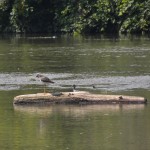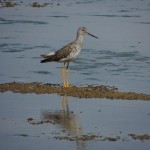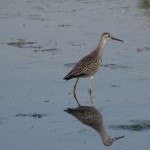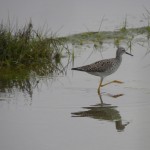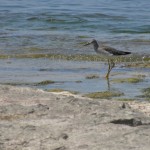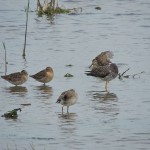11 July 2015. Wingfield Basin, Bruce Peninsula, ON. I was out paddling around Wingfield Basin enjoying a pre-breakfast exploration of its shallow edges when I heard a Greater Yellowlegs calling from high overhead. It was flying purposefully southward, showing no interest in stopping here to forage around the lake’s shallow margins.
I knew by its distinctive call that it was a Greater Yellowlegs, a ringing and far-carrying Tew Tew Tew Tew. Its semi-sibling, the Lesser Yellowlegs, which is confusingly similar in almost all respects except overall size and relative bill length, has a call that is less strident and usually comprises just two, softer tew tew notes, rather than three or more.
Assuming its internal compass is not defective and that it’s not hopelessly lost, it’s my suspicion that this bird was on its southbound, ‘fall’ migration. Quite possibly it’s a one-year-old bird that failed, for any number of reasons, to breed. Local records contain a few records of one-year-old yellowlegs that never quite complete the spring migration back to the mosquito-rich, sub-arctic lands of their origins but instead wander aimlessly around, a thousand or so miles short of their predestined breeding grounds. Nevertheless, the overwhelming majority of yellowlegs of both species are now, still in the far north completing their breeding cycle.
Many of this year’s hatch will now be semi independent and capable of flight, but they need a few more weeks of growth and development before they will start their migration south. We generally don’t see the current year’s young on their fall migration until well into August and the flow of all ages of yellowlegs continues into September and October.
As ‘fall’ migrants go, today’s Greater Yellowlegs was definitely an early bird. If you were overly sensitive to signs of approaching summer’s end it might be a touch discouraging. But it’s still high summer, holiday season to most of us and the odd aberrant sighting only enlivens the days.
Here is a gallery of photos from past days, some are Greater Yellowlegs, some Lesser Yellowlegs. There’s not a lot of difference between the two species, except overall size (for which you need something to compare with) and relative bill length, as I noted above. I think I have i.d them properly but welcome any hair-splitting discussions if you think I’m wrong. One photo is of mostly Short-billed Dowitchers with one dozing yellowlegs. The gallery is visible only on the website, not if you’re reading this as an email.
